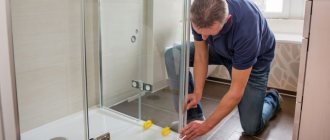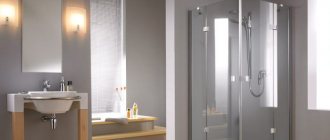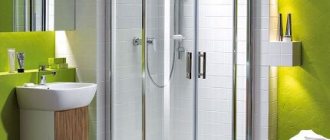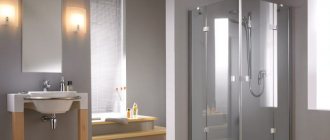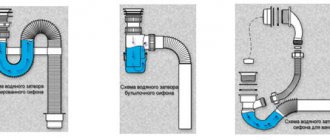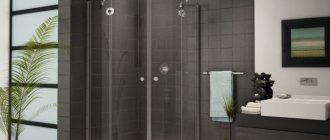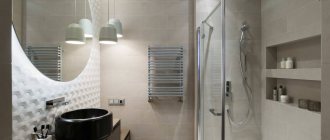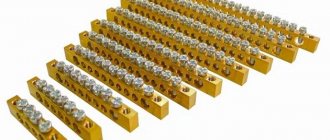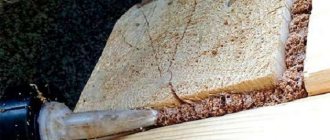If the sewer pipe outlet is located higher than the drainage system of the plumbing fixture, installation of a shower pump is required. To choose this device correctly, you need to study all the available types, evaluate the advantages and disadvantages of each.
Shower pumps are in great demand among consumers.
Scope of application
A sewer pump is used when it is impossible to organize a gravity drainage system. For example, if a shower stall, dishwasher or washing machine is installed below a sewer pipe.
The pump forces wastewater into the pipe. This helps to move sanitary and utility rooms to the basement floors. Pumps are placed in bathrooms, kitchens, and laundries.
A device equipped with a grinder is installed if the sewerage system has not yet been connected to the bathroom. In this case, the cabin is connected to a pump, which is connected to a common line. The difference from a gravity system is:
- smaller diameter of outlet pipes;
- possibility of raising water to a height of up to 9 m;
- horizontal movement of wastewater over a distance of up to 10 m (minimum slope required).
A sewage pump is used if it is impossible to organize a gravity system.
These features help connect the cabin drainage system to the sewer system in any room.
What will be needed for repairs?
If the presence of a malfunction is still confirmed, then it’s time to start replacing the heating element. But before you get started, you need to acquire all the necessary tools. The list is small, but without it it’s unlikely that anything will be done.
For repair you will need:
- spanners;
- pliers;
- rags or napkins - they should absorb water well;
- screwdrivers - it is advisable to stock up on Phillips and straight screws;
- phase meter - the tool is a screwdriver with a special indicator built into the handle;
- new heating element.
Armed with everything you need, you can proceed directly to the repair. For everything to be successful, you need to follow a certain order of actions, which will be discussed below.
Although the vast majority of boilers differ from each other in appearance and characteristics, as a rule, they have an identical design
Types of pumps for shower stalls
Devices are divided into:
- Rod type, used mainly for supplying water from a shallow well. The motor is located at the top.
- Rodless, with joint arrangement of elements. In addition to the pipes, a power cable is connected to the housing.
Pumps for shower stalls are rodless.
Price overview
Water heater heating elements are sold in special branded stores (the price will be high here), they can also be bought on the Internet or in regular markets. Strictly ensure that the model of the heating element, its type and parameters match those of the water heater from the same series. Price Evan (Evbo-1) 90 V:
| City | Price, rubles | City | Price, rubles |
| Ekaterinburg | 1100 | Izhevsk | 1100 |
| Kazan | 1200 | Moscow | 1250 |
| Nizhny Novgorod | 1200 | Oka | 1100 |
| Permian | 1100 | St. Petersburg (SPb) | 1200 |
| Saratov | 1100 | Tyumen | 1200 |
| Samara | 1100 | Ufa | 1100 |
| Chelyabinsk | 1200 | Voronezh | 1200 |
How the device works
The device consists of a pump and a durable polymer reservoir. Some models are equipped with a chopper. The sensor monitors the liquid level in the container, triggering when it is full. After this, the pump and grinder are started, and the wastewater is forced into the sewer. The second sensor stops the supply of electricity when the wastewater level drops. The standard device has 1 or 2 pipes.
The principle of operation of the pump.
More productive options are equipped with 4 taps. The tank has several inlet holes, 1 is the outlet.
Reasons for replacing the heating element
It is necessary to replace the heating element if the old element fails. But how can you determine that the heating device has actually burned out? To do this, you need to plug in the boiler and wait until it reacts.
If the device turns off immediately, then this is a clear sign of a problem. Well, in the case when the equipment continues to operate, there are no malfunctions and, accordingly, there is no need for repairs.
If the boiler constantly knocks out plugs in an apartment or house, then this is a good reason to start repairing it, namely replacing the heating element
To be completely convinced that a part is faulty, you need to “ring” it, so to speak. Simply put, evaluate the conductive characteristics.
To do this, the following procedure must be followed:
- unplug the equipment from the outlet;
- unscrew the protective cover;
- find the contacts of the heating element;
- check component resistance.
For testing, you can use an ohmmeter or multimeter. If the measuring device shows “infinity,” then the heating element has become unusable (burnt out) and needs to be replaced. Well, when the device shows zero or any exact number, then there are no problems.
Tray with built-in pump
The design is equipped with a box containing a device for pumping out water. It is installed on the drain and connected to the electrical network. The pump is triggered when water begins to flow into the hole in the pan. The device is equipped with a float that closes the electrical circuit. The design is safe, because the wires and contacts are in an insulated box.
The system is completely ready for operation; the only drawback is its high cost.
Advantages and disadvantages of use
The positive qualities of the devices in question include:
- Possibility of arranging a drainage system without performing labor-intensive work.
- Ensuring normal drainage of wastewater when the pan is located below the entry point into the common line. Possibility of using pipes of smaller diameter. Most devices are connected using 28-40 mm polypropylene elements. Such communications are easier to hide; they do not attract unnecessary attention, unlike standard 100 mm lines.
Filters ensure normal drainage of wastewater.
Disadvantages include:
- Dependence on the operation of the electrical network. If there is no power, the water does not drain. A backup source helps ensure uninterrupted operation of the system.
- Increased noise level. Manufacturers are trying to improve devices, but they cannot completely get rid of extraneous sounds.
- The need to comply with operating rules. Hair and fibrous particles should not get into the drain. If the shredder handles toilet paper well, threads can clog it. This reduces the quality of the device. Over time, the screw becomes blocked. The overheating sensor turns off the pump. The unit has to be disassembled and cleaned.
- Possibility of burnout. With proper selection and operation, pumps operate for at least 5 years. If equipment operates under wear and tear, it quickly breaks down. When choosing performance, it is worth leaving a margin.
Purchasing the necessary materials
In addition to making or purchasing a heating tank, you must purchase plastic water pipes D 50 mm. It is convenient to use a flexible silicone hose to supply water.
To set up a system of materials you will also need:
- gutter reinforced with metal mesh;
- ball valve;
- valve with float;
- divider
To make a foundation pour when constructing a cesspool, you will need cement marked M150 and higher. The drain can be covered with waterproofing roll materials or hydroglass insulation.
To make a wooden floor in the shower, it is best to use a tongue-and-groove board, treated with a water-polymer emulsion or oil white.
For the final finishing and arrangement of the bathroom, you will need paint for exterior and interior work, spacious shelves for bathroom accessories and hooks for clothes.
To erect the structure you will need the following tools:
- building level;
- roulette;
- corner;
- screwdriver;
- self-tapping screws
To pre-mark the area, you also need to stock up on a skein of twine and wooden pegs.
Connection and installation features
The pump is installed in an accessible place. Regular maintenance is not required, but the unit may become clogged. During installation, observe the following rules:
- Mains powered devices require grounding. They are connected to a 3-wire outlet. The electrical line is supplied with separate RCDs and an automatic circuit breaker.
- The body is attached to the floor. The rubber backing helps reduce installation noise.
- The outlet part of the system is assembled from a rigid pipe. You can use copper or plastic products. Permanent fittings are used for connection.
- The pipeline is fixed to the floor or wall.
Pan with pump - self-assembled
You won’t be able to assemble a complex drainage structure with your own hands. However, you can make a simple country shower with a pump. For this you will need:
- foot device for inflating wheels;
- container with a tight-fitting lid;
- 2 pieces of rubber hose;
- 2 pieces of pipe of different diameters;
- valve;
- shower head.
A tray with a pump is the basis of the shower cabin, which drains water.
The pallet is assembled like this:
- 2 holes of different diameters are formed in the lid of the prepared container.
- Tubes are inserted. The element inserted into the larger hole is immersed to the bottom.
- Rubber hoses are placed on the tubes. A watering can is attached to the wider one. A narrow hose is connected to a foot pump.
The watering can can be replaced with an umbrella with a tap. When the water supply stops, pressure will build up. Once opened, the liquid will flow steadily. If assembled correctly, a country shower can last for several years.
How to make your own thermostat for a water heater
If the budget is very limited when making a water heater, then you can make a thermostat for the water heater with your own hands. The thermal breaker is installed as follows:
- Remove the thermal relay from a faulty car of any brand that controls the inclusion of forced engine cooling.
- Set the thread type of this part.
- Select a metal tube of suitable diameter and use a tap to cut the internal thread.
- Make a hole in the instantaneous water heater and weld a threaded tube.
- Screw in the thermostat, having first applied high-temperature sealant to the threads.
For the correct functioning of the heating element switching system, you cannot do without using an additional 12 V source and an intermediate relay. The relay installed in the system must be of reverse action, that is, it must open the circuit when low-voltage voltage is applied to the coil. This feature is due to the fact that in a car, the radiator blower is turned on when a certain temperature value is exceeded, while the flow radiator must be turned off at the moment when the temperature value exceeds a critical value.
Rules for choosing sewage pumps
When purchasing a device, take into account the following characteristics:
- Presence of a chopper. This element is not required when connecting the device to a shower stall. The pump with the grinder is connected to the toilet.
- Productivity (volume of water discharged per unit of time). Manufacturers offer devices with both minimal and large parameters. Capacity is selected taking into account the type of plumbing fixtures connected and the volume of water consumed.
- Operating temperature range (40...90 °C). For shower cabins, devices that work with medium-temperature water are suitable.
- Duration of the working cycle. Some settings do not turn on for long. No more than 2 plumbing fixtures can be connected to them. Pumps with a long operating cycle are used to remove wastewater from all areas of the house. In the technical data sheet, the parameter is written as a percentage. For example, if 50% is specified, the installation runs for 30 seconds. It spends the same time on cooling.
When purchasing a device, its performance is taken into account.
Sewage pumps are not designed for bathtubs. When pumping out a large volume of water, the device overheats and stops.
Only a few models are capable of coping with this task.
Categories of heating elements by type of contact with liquid
In a dry heating element, there is no contact with water, which prolongs the service life of the part.
Inside the heating element, a nichrome spiral is hermetically sealed to heat water, and the space between it and the outer walls is filled with quartz sand. The outer tube can be made of copper, carbon steel or stainless steel.
Open heating elements come into direct contact with water. Their main advantage is the high speed of heating the liquid and low cost, but there are also significant disadvantages:
- limited service life;
- rapid formation of limescale;
- high electricity consumption;
- insecurity.
Closed ones do not come into contact with water. The heating element is protected by a durable bulb. Its advantages:
- the likelihood of an electrical short circuit is reduced;
- easy to repair and maintain;
- serve for a long time - three times longer than open heating elements;
- consume significantly less electricity than open-type heating elements.
There are two important disadvantages: high price and slow water heating.
Manufacturers of sewage pumps for shower cabins
Few companies produce such installations. However, the price range is quite wide. European-made devices are considered the best; you should avoid buying low-quality Chinese models.
Grundfos Sololift
The company has released an improved series of pumps. The devices do not contain moving elements in contact with wastewater. The exception is the shredder. The features of the device are:
- tightness of the case, the ability to connect to any plumbing fixture;
- presence of a steel cutter and check valve;
- placement of the air valve and filter in the lid;
- presence of a water level sensor;
- 3 outlets for connecting a shower cabin, washbasin, bidet;
- absence of unpleasant odors in the room when cleaning the unit independently;
- ease of access to the main components of the system;
- power 300 W, lifting wastewater to a height of up to 6 m.
Grundfos Sololift has a sealed housing.
Sanidouche Flat
The mini-pump is designed to connect showers, toilets, and sinks. Sanidouche products are characterized by reliability, lower cost than the previous model. The equipment is installed in a standard way - it is placed in a convenient place. However, it must be taken into account that the drainage must begin from a vertical segment, if there is one on the sewer line.
Sanidouche Flat is designed for connecting a shower.
If this is not possible, the length of the horizontal part should not exceed 30 cm.
Sanifloor (1, 2, 3)
A series of devices is designed for arranging a drainage system in cabins without a tray. Compact devices consist of a siphon and a pump. The latter automatically turns on when water enters the flask. The power of the systems is 400 W. For connection, pipes with a diameter of 32 mm are used. The device quickly discharges wastewater into the centralized sewer system from a distance of up to 30 m. A useful function is the accelerated pumping of water.
Sanifloor is needed for shower enclosures without a tray.
CompactLift Aquatic
Budget installations are designed for connection to toilets and showers. The main advantage is considered to be reduced noise level. The company produces 3 versions of devices:
- Compact LIFT 250. The equipment is designed for the removal of wastewater without paper and feces. The power is 250 W, the water removal rate is 120 l per minute.
- Compact LIFT 400. This model can be used to connect not only showers and sinks, but also toilets. Productivity reaches 150 l per minute, power - 400 W.
- Aquatik Compact LIFT 400 A. Designed for bidets and wall-hung toilets. The technical characteristics are the same as those of the previous model.
CompactLift Aquatik is a budget installation.
Stp Jamix
The series of mid-price devices includes the following models:
- STP-100. The device is equipped with 1 main and 2 auxiliary inputs. A power of 600 W and a capacity of 200 l per minute allows you to simultaneously connect a bidet, shower, and sink. The pump works with hot water and is capable of lifting wastewater to a height of up to 9 m.
- STP-400 Lux. Has similar capabilities to the previous model. However, the water temperature should not exceed +40°C.
- STP-200. It is characterized by lower power and the presence of 3 inputs. The pumping speed is 100 l per minute. Water rises to a height of up to 8 m and is transported horizontally over a distance of 80 m. The device is not designed to work with too hot water.
- STP-250. The model is designed to drain liquid without paper and feces. There are entrances for a sink, shower and bidet. The pumping speed is 80 l per minute. Wastewater is transported over a distance of no more than 50 m.
Stp Jemix is a mid-priced device.
Willo pumps
The German company produces reliable sewerage equipment. It is made of durable plastic and equipped with durable motors. The following models exist:
- HiDrainlift 3-24. Designed for drainage of wastewater without solid impurities. Productivity does not exceed 60 liters per minute.
- HiDrainlift 3-25. Used to drain water from toilets, showers, and sinks. Productivity reaches 100 liters per minute.
- HiSewlift 3-15. Equipped with a main entrance for connecting a toilet, an additional one for a bidet, sink or shower. The device discharges no more than 75 liters of wastewater per minute.
- HiSewlift 3-35. Up to 4 plumbing fixtures can be connected to this pump. It consumes 400 W of energy and discharges 75 liters of wastewater per minute.
- HiSewlift 3-I35. The compact unit has the same features as the previous model.
- DrainLift XS-F. The model is designed for installation in a wall niche.
- DrainLift TMP 32. The pump is designed for the removal of gray wastewater - without solid impurities. There are outlets for connecting dishwashers and washing machines.
- DrainLift TMP 40. The device works with wastewater without solid impurities. It is possible to connect washing machines.
Willo pumps are made of plastic.
Willo's wide range of home pumping units helps you find a model that meets all your requirements.
Drain pit equipment
From a biochemical point of view, draining wastewater from the shower and street toilet into a common pit is a gross mistake. It is necessary to build a separate pit under the cabin. To equip a summer shower, which is supposed to be used only from time to time, a drainage hole with a capacity of no more than two cubes is sufficient.
When calculating the required volume of a structure, adhere to the rule that its capacity should be 2.5 times greater than the contents of the water tank
The drain should not be located under the shower building itself or even near its walls, but two to three meters from the building.
This arrangement allows you to solve two problems at once:
- prevent the appearance of unpleasant odors of decaying organic matter;
- minimize the risk of foundation failure.
To construct a drainage pit, dig a pit 2-2.5 m deep. At this depth, wastewater will be discharged into the soil below the fertile layer. Thanks to this, soil microliving creatures will not suffer from such a “neighborhood”.
To make drainage, the bottom is lined with gravel and sand. The thickness of the drainage layer should be 20-30 cm.
When creating a waterproof layer, you should not use clay, since during operation, as a result of the natural erosion process, it can simply break the drainage system.
To avoid shedding of the walls of the drainage pit, they must be laid out in several rows with bricks or decorated with used tires.
The upper part of the drainage pit must be tightly closed. The lid can be made from a wooden panel or a piece of sheet metal.
The technology for constructing a tire drainage pit is described in this article.
